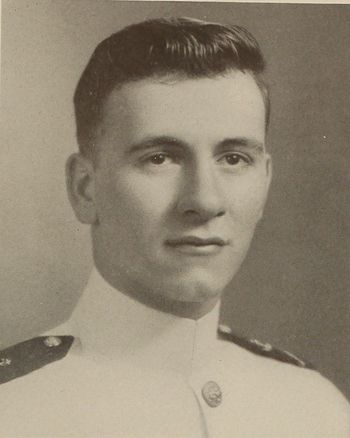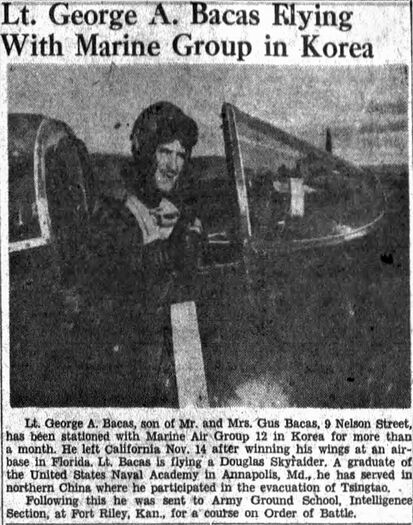GEORGE A. BACAS, MAJ, USMC
George Bacas '48
Lucky Bag
From the 1948 Lucky Bag:
George Augustus Bacas
Glen Falls, New York
If you have never heard of Hometown, U.S.A., "G. A." Bacas will politely, but definitely, inform you that it is his town, Glen Falls, N.Y. This product of the Adirondacks is noted for his inquisitive mechanical mind, happy-go-lucky attitude, and very pleasing mannerisms, which make him a most respected and admired member of the class. George, like many of the lads here, hasn't garnered any N's, but his enthusiastic participation in intramural sports is reflected by the accomplishments of the teams of which he has been a member. George cannot help but make his Naval career a successful one, for his industry, understanding, and enterprise rate him 4.0.
George was 3rd Battalion Sub-Commander (1st set). He graduated with the class of 1948-A, the last of the wartime-accelerated classes, in June 1947. (The bottom half of the class by academic standing, designated 1948-B, completed an extra year and graduated in June 1948.)

George Augustus Bacas
Glen Falls, New York
If you have never heard of Hometown, U.S.A., "G. A." Bacas will politely, but definitely, inform you that it is his town, Glen Falls, N.Y. This product of the Adirondacks is noted for his inquisitive mechanical mind, happy-go-lucky attitude, and very pleasing mannerisms, which make him a most respected and admired member of the class. George, like many of the lads here, hasn't garnered any N's, but his enthusiastic participation in intramural sports is reflected by the accomplishments of the teams of which he has been a member. George cannot help but make his Naval career a successful one, for his industry, understanding, and enterprise rate him 4.0.
George was 3rd Battalion Sub-Commander (1st set). He graduated with the class of 1948-A, the last of the wartime-accelerated classes, in June 1947. (The bottom half of the class by academic standing, designated 1948-B, completed an extra year and graduated in June 1948.)
Loss
George was lost on January 11, 1961 when the A3J Vigilante he was piloting crashed while landing at Patuxent River Naval Air Station. George had radioed the tower about a problem with the flaps before attempting an emergency landing.
Another officer aboard, LT William A. Fitzpatrick, was also killed. They were the first two active duty servicemen to be lost while operating the Vigilante, and George was the only Marine lost. (Thank you to Steve Ewing for correcting an error and providing additional information.)
Other Information
From researcher Kathy Franz:
George graduated in 1943 from Glens Falls High School receiving the College Entrance diploma. He later attended Bryan Preparatory School in Annapolis. He received the first alternate appointment to the Naval Academy from Rep. Dean P. Taylor.
After graduating from the Naval Academy, George was on duty as an instructor with Marine Corps School, Marine Barracks, Quantico. In September 1948, his next duty station was Tsingtao, China, where two battalion landing teams were stationed as an outpost for the protection of the Marine Airfield there and American interests located in North China.
In 1949, he participated in the evacuation of Tsingtao, last Nationalist stronghold north of Shanghai. He then returned in May to the Army Ground School, Intelligence Section, at Fort Riley, Kansas, for a three-month course on Order of Battle.
In June 1951, he was stationed at the Naval Auxiliary Air Station, Corry Field, Pensacola, for instrument and night flying training. He already had completed his basic flight training. In November, he reported to Corpus Christi for advanced flight training, and he received his wings in June 1952.
In January 1953, George was a member of the Wolfraiders Squadron of the First Marine Aircraft Wing in Korea. He was a pilot of a Corsair attack bomber.
In April that year, George was awarded the Air Medal for meritorious acts in aerial flight against the enemy in Korea. Cited by Major General V. E. McGee, commander of the First Marine Aircraft Wing, the citation reads:
“For meritorious acts while participating in aerial flight against the enemy while attached to the 1st Marine Aircraft Wing in Korea from 5 December 1952 to 31 December 1952. Captain Bacas successfully completed his first through twentieth missions against the enemy where enemy fire was either expected or received. His courageous action and devotion to duty throughout were in keeping with the highest tradition of the United States Naval Service.”
In January 1958, George was stationed in the Cherry Point Marine Air Station, Virginia.
He married the former Jean Shirley Currier of Salisbury, Massachusetts, on April 21, 1951, at the naval station chapel in Pensacola. She was an ensign in the Navy nurse corps.
His father was Gus, mother Helen, and three brothers: Angelo, William, and Marine Sgt. James G. Bacas. His parents were both born in Greece.
From Find A Grave:
Major Bacas had been decorated with the Distinguished Flying Cross and Air Medal with six stars. He is survived by his wife, Jean Courrier Bacas; daughters Cathy Jean, 4, and Karen Lee, 3, in addition to his mother.
He is buried in Arlington National Cemetery with his wife.
From Arlington National Cemetery:
I am one of two daughters of George and Jean Bacas.
My Father was a Test Pilot at Patuxent Naval Air Station and he was killed while flying a A3J or A5J Vigilante there.
My Mother died from Ovarian cancer. Please contact me if I can be of further assistance. Karen B. Peterson, kpeterson@mif.aero
Photographs
Distinguished Flying Cross
From Hall of Valor:
The President of the United States of America takes pleasure in presenting the Distinguished Flying Cross to Captain George A. Bacas (MCSN: 0-49327), United States Marine Corps, for extraordinary achievement while participating in aerial flight against the enemy in Korea. On 18 January 1953, Captain Bacas led a flight of Marine Attack Aircraft against a heavily defended concentration of enemy mortars then firing on elements of the Sixth Republic of Korea Division. He promptly located the cleverly concealed positions in a valley and initiated an aggressive bombing attack through a heavy defensive crossfire from nearby ridges. Scoring direct hits with his bombs, he then led and directed his flight in the complete destruction of the mortar positions. Observing several adjacent hostile installations Captain Bacas immediately pressed a low level diving assault and set fire to several personnel shelters with a napalm bomb. He resolutely continued to lead his flight in repeated attacks until one hundred per cent coverage of the target area was accomplished. Captain Bacas' courageous actions and his outstanding leadership in organizing and directing his flight were largely responsible for the success of a mission that substantially reduced enemy pressure on front line positions of friendly troops. His exemplary conduct, professional skill, and steadfast devotion to duty throughout were in keeping with the highest traditions of the United States Naval Service.
General Orders: Commanding General 1st Marine Aircraft Wing: Serial: 7160 (May 7, 1953)
Action Date: January 18, 1953
Service: Marine Corps
Rank: Captain

The "category" links below lead to lists of related Honorees; use them to explore further the service and sacrifice of alumni in Memorial Hall.


